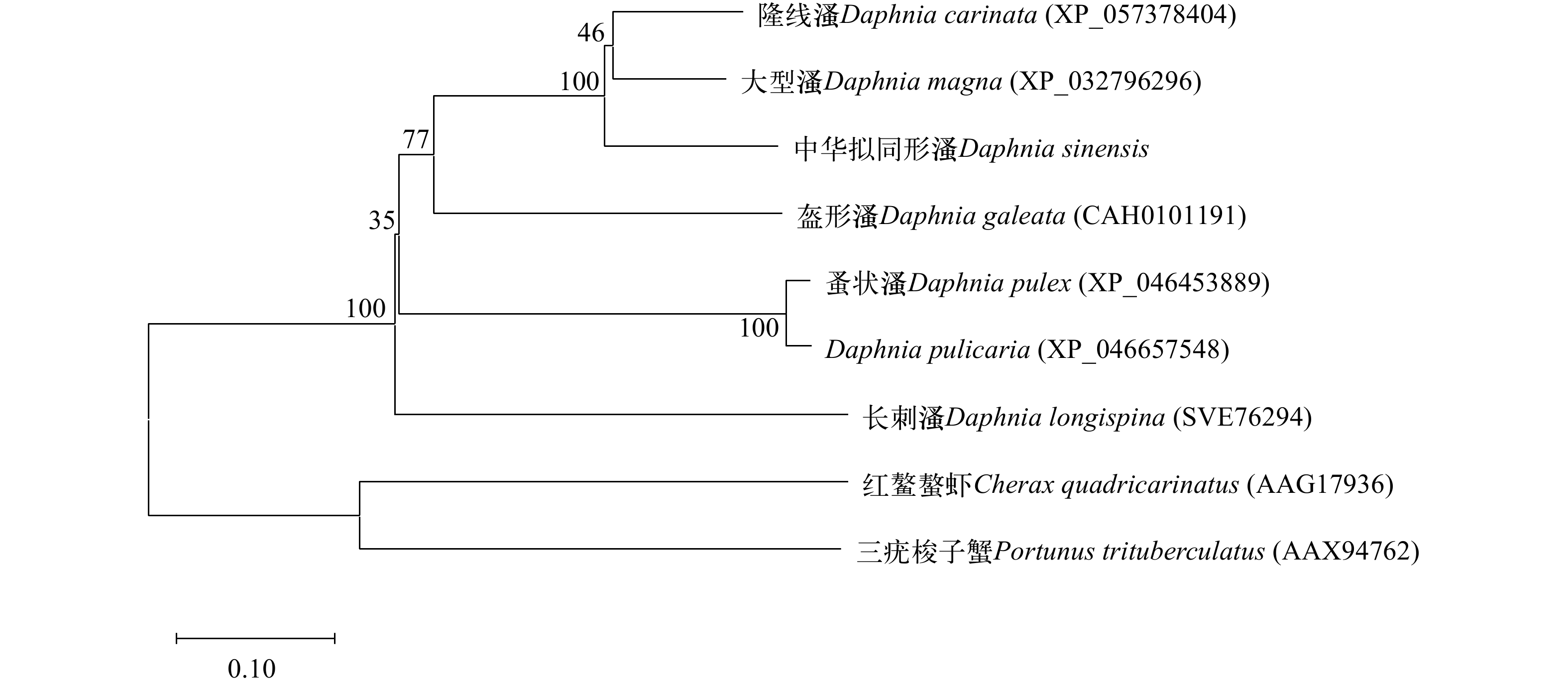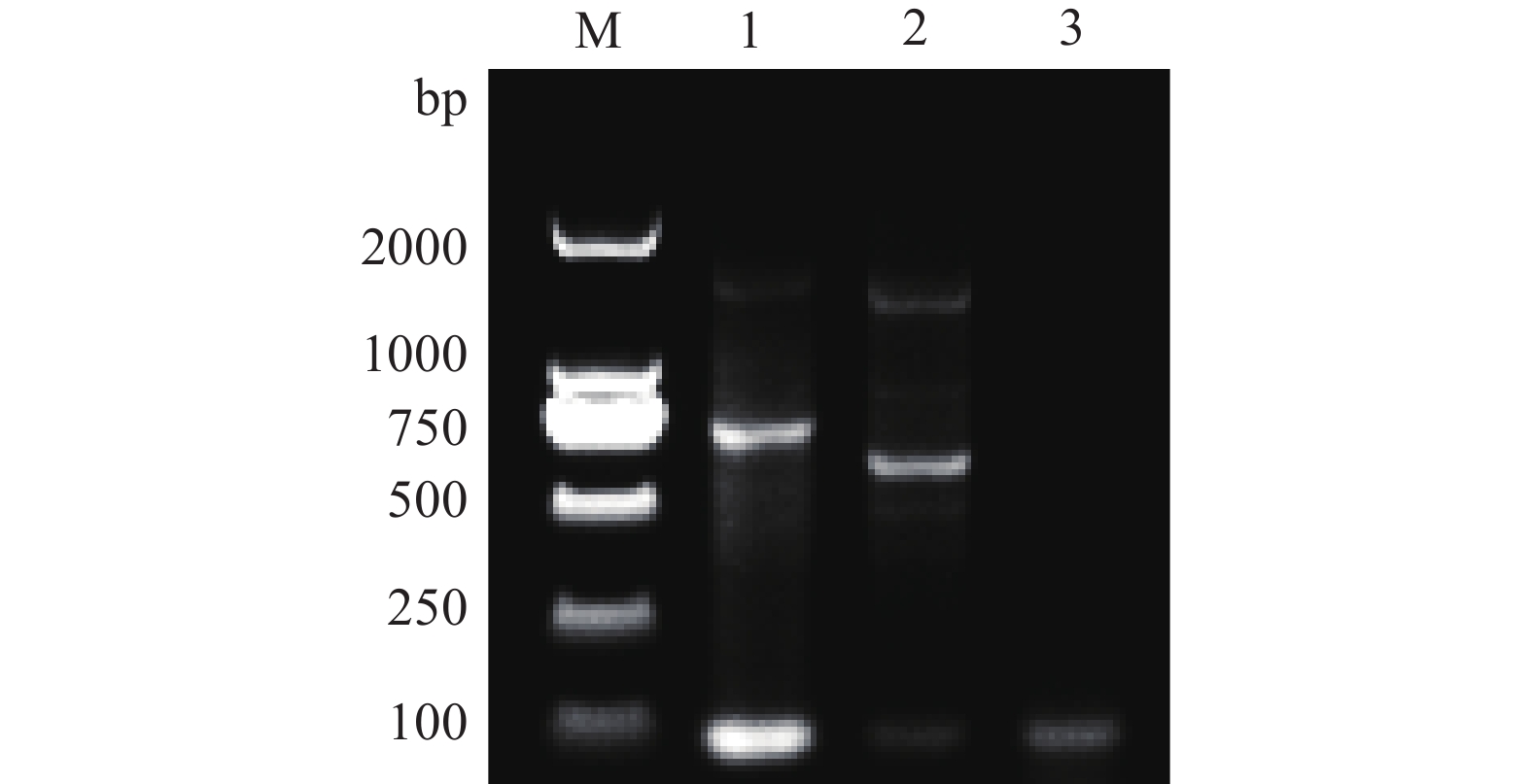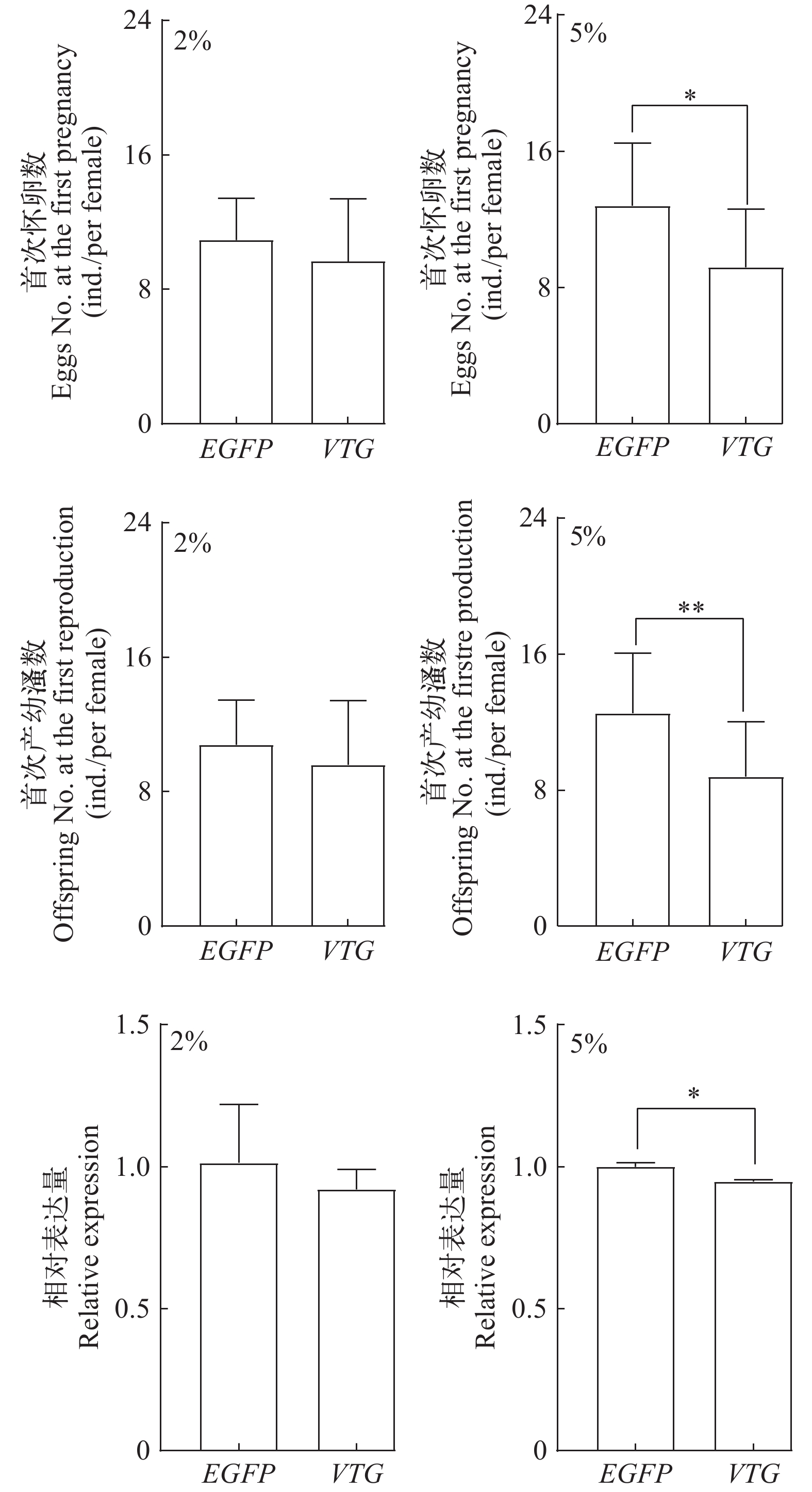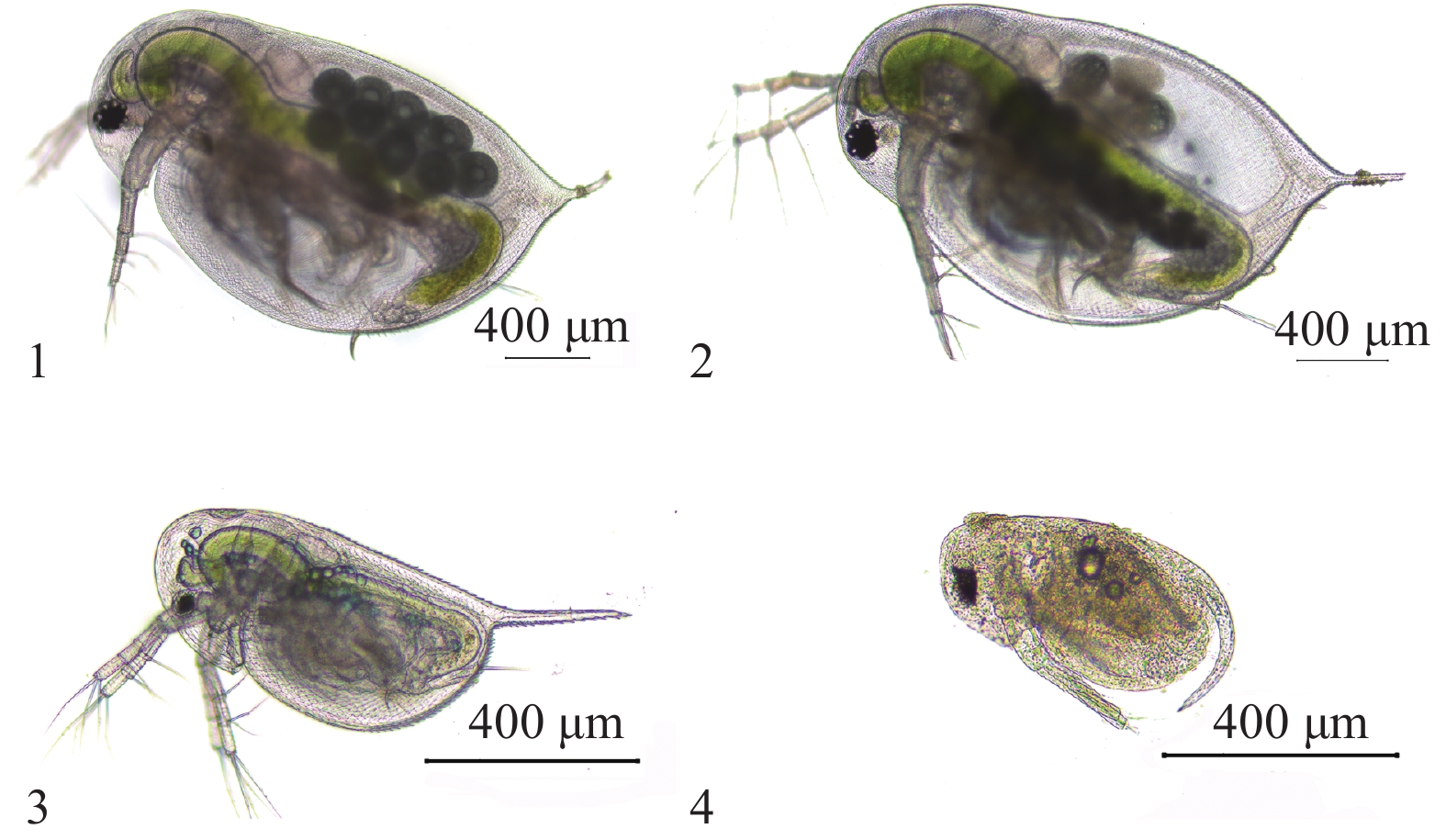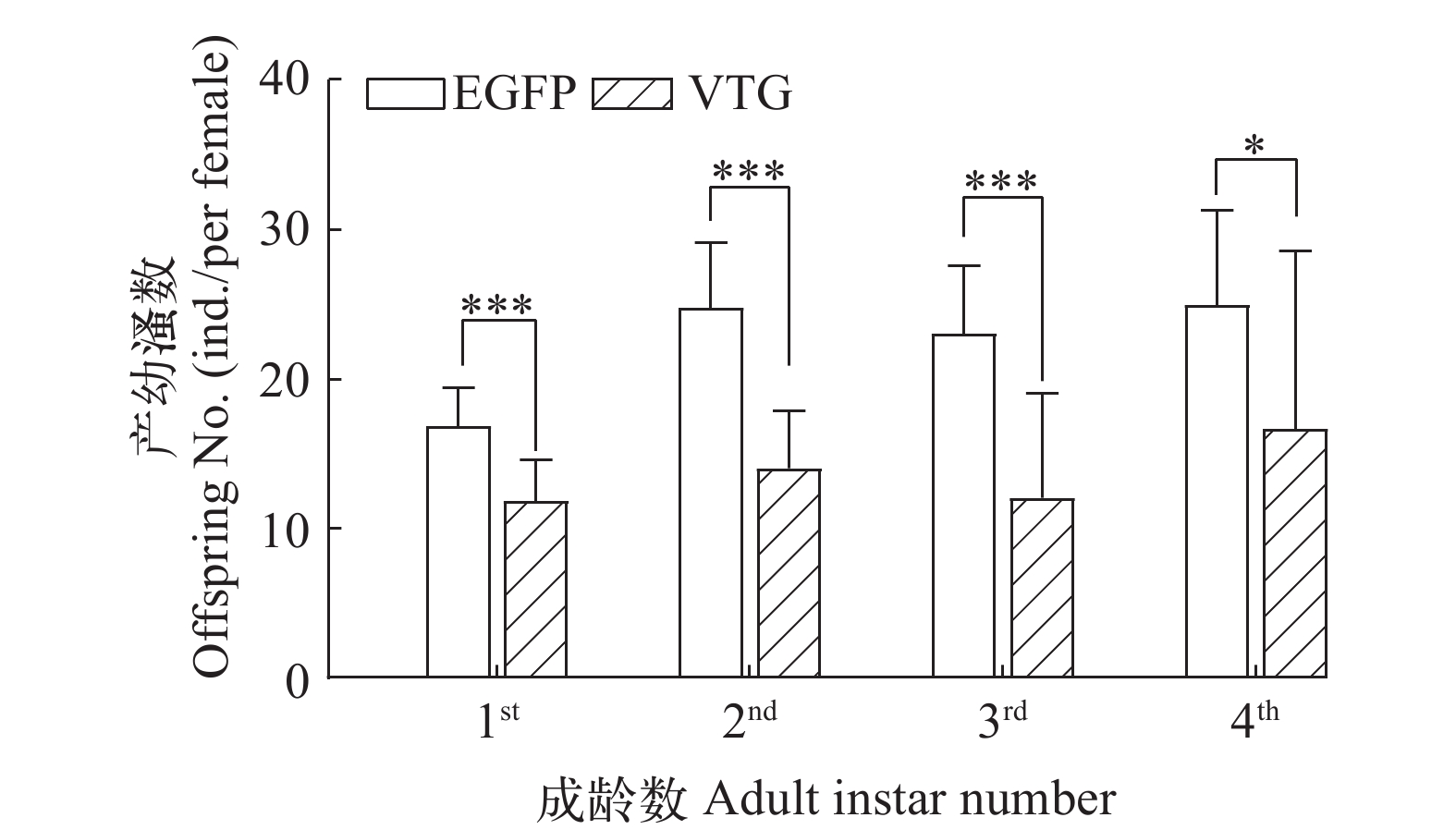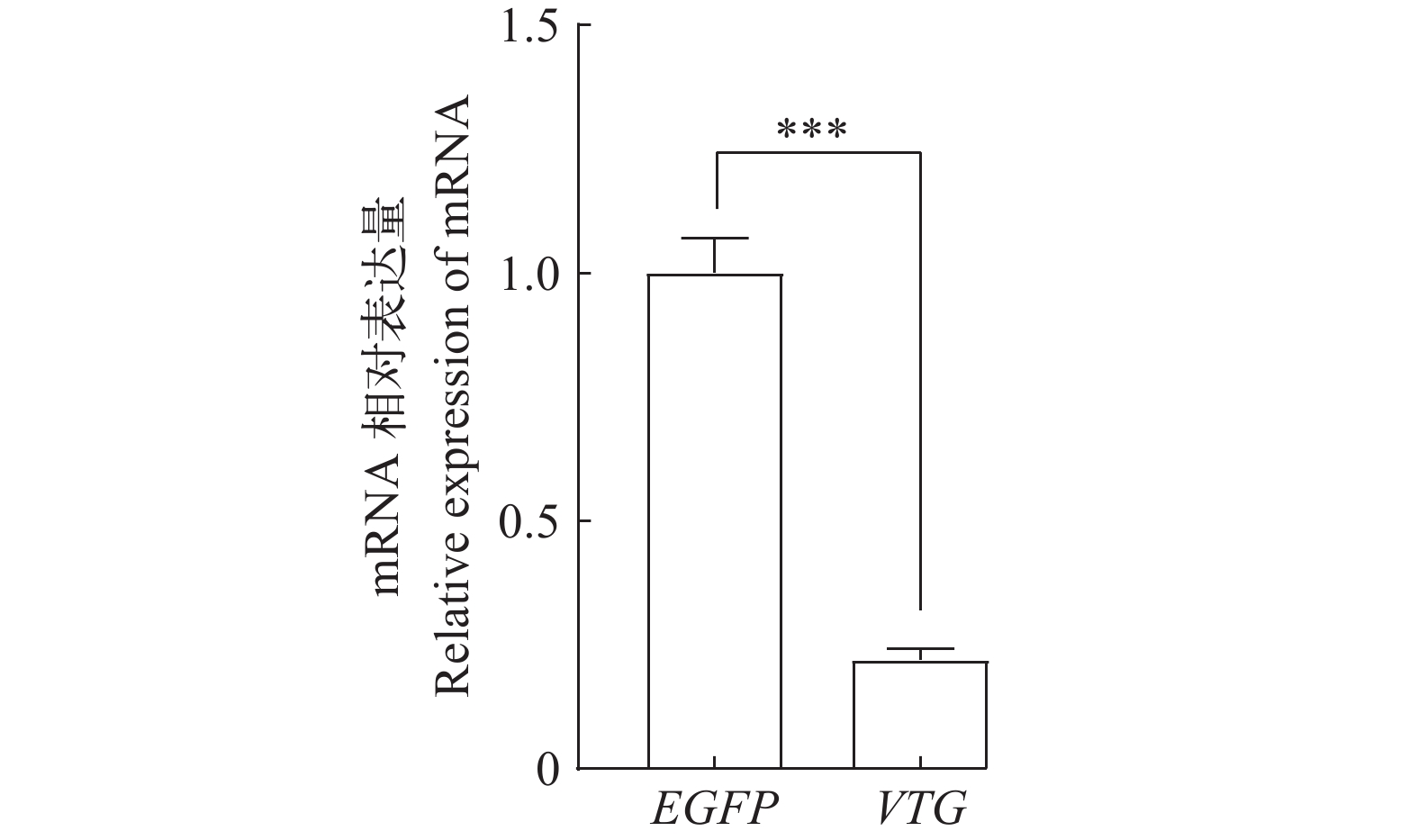EXPRESSION AND FUNCTIONAL ANALYSIS OF THE VITELLINOGEN GENE IN DAPHNIA SINENSIS
-
摘要:
为了阐明卵黄蛋白原基因对溞属枝角类生殖和胚胎发育的影响机制, 研究了RNA干扰下中华拟同形溞(Daphnia sinensis)的卵黄蛋白原基因表达及产幼溞数变化。结果表明, RNA干扰后, 与EGFP (Enhanced green fluorescent protein)组相比, 2%大肠杆菌浓度下中华拟同形溞在Vtg组的首次产幼溞数和Vtg基因相对表达量没有显著差异; 5%大肠杆菌浓度下中华拟同形溞前四个成龄在Vtg组的产幼溞数均显著小于EGFP组, 且中华拟同形溞的第一成龄、第四成龄时在Vtg组的Vtg基因相对表达量均显著小于EGFP组, 分别下降了5.25%和78.03%。此外, RNA干扰后Vtg组的中华拟同形溞还出现了胚胎消解和后代发育不全的现象。结果表明, 高强度、长时间的RNA干扰能够显著降低中华拟同形溞Vtg基因的相对表达水平, 也能够显著抑制其生殖量和胚胎发育。因此, Vtg基因对中华拟同形溞的生殖和胚胎发育起重要作用。
Abstract:In order to elucidate the mechanism of the influence of vitellinogen gene on the reproduction and embryonic development of Daphnia, the changes on the expression of vitellogenin gene and the number of offspring of D. sinensis under RNA interference (RNAi) was studied. After RNA interference, compared with the EGFP (Enhanced Green Fluorescent Protein) group, there was no significant difference in number of offspring at the first reproduction or relative expression level of Vtg gene of D. sinensis in the Vtg group at the 2% E. coli concentration. At the 5% E. coli concentration, the number of offspring at the first four adult instar in the Vtg group were significantly lower than those in the EGFP group. Additionally, the relative expressions of the Vtg gene of D. sinensis at the first and the fourth adult instars in the Vtg group were significantly lower than those in the EGFP group, with decreases of 5.25% and 78.03%, respectively. In addition, the phenomenon of embryonic digestion and underdevelopment of offspring also appeared in the Vtg group after RNAi. The results suggest that high-intensity and prolonged RNA interference can significantly reduce the relative expression of the Vtg gene in D. sinensis, leading to a marked inhibition of reproductive capacity and embryonic development. Therefore, the Vtg gene plays an important role in the reproduction and embryonic development of D. sinensis.
-
Keywords:
- Vtg gene /
- Reproduction /
- Functional analysis /
- Daphnia sinensis
-
枝角类是一类小型浮游甲壳动物, 隶属节肢动物门(Arthropoda)、甲壳纲(Crustacea)、双甲目(Diplostraca)。枝角类既能够滤食水体中的藻类、细菌和有机碎屑, 又是鱼类的饵料, 在水生食物链中起承上启下的作用[1]。由于易于培养、生长周期短且对环境变化敏感等特点[2], 它们可以作为模式生物, 被广泛地应用于生态毒理学、种群遗传学、性别进化和表型可塑性等研究领域[3]。枝角类具有孤雌生殖和两性生殖两种生殖方式。通常, 它们在环境良好时行孤雌生殖, 迅速扩大种群, 而当环境恶化时行两性生殖, 产生休眠卵, 以适应不良的环境。已有的研究表明, 温度、食物和鱼类信息素等环境因子是影响溞属枝角类生殖的重要因素[4—6]。温度能够影响溞属枝角类卵的产生和胚胎发育, 水温过高或过低都会导致其生殖量下降[7]。Chakri等[4]发现, 鱼类信息素的胁迫导致大型溞的繁殖提前, 产后代数的增加。
通常, 卵黄蛋白原是卵生动物(如甲壳类动物)雌性个体卵黄蛋白的前体, 而卵黄蛋白是储存在卵母细胞中卵黄的常见形式, 是胚胎发育的营养来源。卵黄蛋白原(Vitellogenin, Vtg)是一种高分子量(200—600 kD)的磷酸酯糖蛋白。无脊椎动物的卵黄蛋白原一般由多个亚基组成, 而鱼类的卵黄蛋白原由两个同源二聚体组成, 其相对分子质量为150—220 kD[8]。在激素诱导的鸡血浆中, Wang等[9]纯化出3种结构和分子量不同的鸟类卵黄蛋白原。因此, 不同种类动物的卵黄蛋白原在结构和功能上有一定的相似性, 但存在明显的差异性。卵生动物(如甲壳类动物)中, 卵黄蛋白原的合成是卵巢发育的重要步骤[10]。在受体介导的内吞作用下, 卵黄蛋白原被转运到卵母细胞中, 然后水解成卵黄蛋白的硫磺蛋白和磷蛋白, 进而为胚胎发育提供营养物质[11]。此外, 卵黄蛋白原还可以作为分子载体运输多种营养物质、金属离子到卵母细胞中[12—16], 用于卵母细胞的代谢与生长。Yilmaz等[17]认为, 卵黄蛋白原Vtg2在卵黄蛋白膜完整性和其他生殖功能等方面具有潜在作用, 进而能够影响斑马鱼(Danio rerio)的早期胚胎发育。通过RNA干扰敲低松毛虫赤眼蜂(Trichogramma dendrolimi)的卵黄蛋白原受体基因表达水平后, Wang等[18]发现它们的卵巢生长发育受到抑制、卵巢中初始成熟卵的数量显著减少。由此可见, 卵生动物的繁殖受到卵黄蛋白原基因的调控。在甲壳动物中, 有关卵黄蛋白原基因的研究已有一些报道。通过对罗氏沼虾(Macrobrachium rosenbergii) Vtg基因家族的全基因组分析, Jiang等[19]发现了8个卵黄蛋白原基因, 且存在功能差异性; miR-34通过对卵黄蛋白原Vtg及其受体VtgR基因表达的抑制作用, 间接调控了青蟹(Scylla paramamosain) 的卵巢发育[20]。在溞属甲壳动物中, 目前仅在大型溞(Daphnia magna)中获得了2个完整cDNA序列的Vtg基因, 且这2个Vtg基因均具有位于N-端的超氧化物歧化酶样(SOD-like)的结构域[21]。因此, 对溞属甲壳动物的卵黄蛋白原基因的筛选和功能分析还需进一步深入研究。
影响溞属种类生殖的分子机理研究已有一些报道。Transformer (tra)、vasa、角质层蛋白(CP)及化学感受蛋白(CSPs)等基因都可能与溞属种类的生殖有关[22—25]。DHB、Vtg、CYP4等基因的表达变化与大型溞(D. magna)的繁殖能力之间存在一定的关系[26]。Kim等[27]也发现, 卵黄蛋白原基因的表达与大型溞的生殖量密切相关。尽管卵黄蛋白原基因对溞属种类生殖的影响已有一些研究, 但它们的功能验证及其对溞属种类胚胎发育的影响尚未见报道。结合先前的转录组测序结果, 本文筛选出中华拟同形溞(Daphnia sinensis)的卵黄蛋白原基因, 并在RNA干扰(RNAi)下研究了卵黄蛋白原基因的表达水平、功能验证及其对中华拟同形溞生殖和胚胎发育的影响, 其研究结果将为深入探讨溞属种类胚胎发育的分子机制提供基础资料。
1. 材料与方法
1.1 实验材料
斜生四链藻(Tetradesmus obliquus)来自中国科学院水生生物研究所淡水藻种库, 加入BG-11培养基, 在(25±1)℃智能光照培养箱中培养, 光照周期为L﹕D=12h﹕12h, 光照强度为 2500 lx。当斜生四链藻生长呈指数增长时收集, 并在冰箱中4℃下冷藏保存。
中华拟同形溞来自安徽巢湖表层沉积物中的休眠卵孵化。孵化的中华拟同形溞个体放入100 mL烧杯(含80 mL的培养液)中, 在智能光照培养箱中长期培养, 其他培养条件与斜生四链藻相同。食物为20 mg/L的斜生四链藻。经过曝气48h以上并过滤的自来水, 作为其培养液。
1.2 中华拟同形溞Vtg基因的筛选及其序列特征分析
中华拟同形溞Vtg基因的筛选来自赵雅洁等[28]的实验结果, 该基因在Nr数据库注释为卵黄蛋白原(Vitellogenin)。Vtg基因的核酸和氨基酸序列使用NCBI数据库进行同源性比对(http://www.ncbi.nlm.nih.gov); 其核苷酸序列的开放阅读框由在线预测工具ORF finder进行分析(http://www.ncbi.nlm.nih.gov/orffinder), 进而获得Vtg基因的氨基酸序列; 其蛋白质是否存在信号肽由Signal 4.1 Server进行预测(http://ww.cbs.dtu.dk/services/SignalP-4.1), 且其蛋白质是否存在跨膜区域可通过TMHMM网站进行在线预测(http://www.cbs.Dtu.dk/services/TMHMM)。
1.3 中华拟同形溞Vtg基因的系统进化树
利用MEGA 11软件, 对中华拟同形溞Vtg基因的氨基酸序列进行系统发育分析, 以红鳌螯虾(Cherax quadricarinatus)和三疣梭子蟹(Portunus trituberculatus)作为外类群, 使用Neighbor-Joining方法[18], 重置1000次, 构建系统进化树。
1.4 dsRNA的制备
由通用生物(安徽)股份有限公司构建目的质粒(载体为L4440)。将L4440空载、L4440-EGFP质粒和L4440-Vtg质粒分别转化到大肠杆菌HT115感受态细胞中。挑取单克隆菌落在含有四环素(10 μg/mL)和氨苄青霉素(100 μg/mL)的LB培养基中震荡培养至A600≈0.8, 加入IPTG (Isopropyl-beta-D-thiogalactopyranoside)诱导出dsRNA[29]。
1.5 RNA干扰饲喂实验
用含有诱导出Vtg和EGFP基因dsRNA的大肠杆菌进行RNAi饲喂实验。基于戚惠颍等[30]的实验结果, 5%浓度大肠杆菌下RNA干扰效果比10%浓度大肠杆菌下更好, 较高浓度的大肠杆菌可能对中华拟同形溞有一定的副作用。因此, 本实验选择2%和5%两个浓度的大肠杆菌进行实验。实验分两个阶段进行。第一阶段, 实验设置2%大肠杆菌浓度组: 98%斜生四链藻+2%大肠杆菌; 5%大肠杆菌浓度组: 95%斜生四链藻+5%大肠杆菌。食物的总生物量为20 mg/L。实验溞为中华拟同形溞出生时间小于6h的第3代幼溞。每个食物组设有3个平行, 每个平行需15个实验溞。每个实验溞分别培养在50 mL烧杯中, 并在烧杯中加入40 mL培养液。实验期间, 每天更换培养液。培养液为过滤的自来水, 须曝气48h以上。实验持续到中华拟同形溞首次产出幼溞后, 收集中华拟同形溞亲本组织, 使用RNA试剂盒(TaKaRa, 中国大连)提取总RNA, 再使用LightCycler®96荧光定量PCR仪测定Vtg基因的表达水平。同时, 记录中华拟同形溞的首次怀卵数、首次产幼溞数及成熟时间和首次产幼溞时间。
根据第一阶段的实验结果, 第二阶段的实验只设置5%大肠杆菌浓度组(95%斜生四链藻+5%大肠杆菌), 且实验持续到中华拟同形溞第四次产出幼溞时, 以检验较长时间高强度的RNA干扰对中华拟同形溞Vtg基因的表达和生殖的影响。其他实验条件与第一阶段实验相同。当实验持续到中华拟同形溞第四成龄产出幼溞后, 收集中华拟同形溞的亲本组织, 使用RNA试剂盒(TaKaRa, 中国大连)提取总RNA, 再使用LightCycler®96荧光定量PCR仪测定Vtg基因的表达水平。实验期间, 分别记录中华拟同形溞的首次怀卵数、前四个成龄的产幼溞数以及成熟时间和首次产幼溞时间。
1.6 中华拟同形溞Vtg基因表达检测
对已提取的总RNA进行反转录, 再以样本cDNA为模板进行定量分析。每个样本进行3次重复, GAPDH (甘油醛-3-磷酸脱氢酶)作为内参基因, 荧光定量引物通过Beacon Designer软件[28]设计, 设计的引物见表 1。使用LightCycler®96 qPCR测定Vtg基因的相对表达量。qPCR反应体系: 95℃预变性10min; 95℃变性 10s, 60℃退火30s, 40个循环。数据采用2 –∆∆Ct法计算。
表 1 引物的序列及名称Table 1. Sequence and name of primer employed in this experiment引物名称
Primer name引物
Primer (5′—3′)GAPDH TCGTCTCCAATGCTTCTT
CGGTCCATCAACAGTCTTVtg CTTGGAAGGCAATGGAATCCCA
GGATGTGGATCAGGACATTATTGC1.7 数据分析
使用SPSS 21软件[39], 在第一阶段实验中, 采用单因素方差分析(One-ANOVA)中的Tukey HSD[7]分别检验不同浓度下中华拟同形溞的首次怀卵数、首次产幼溞数、成熟时间、首次产幼溞时间及首次产幼溞时Vtg基因的相对表达量在EGFP组和Vtg组间的显著差异; 同样地, 在第二阶段实验中, 采用多重比较Tukey HSD分别对中华拟同形溞的成熟时间、首次产幼溞时间、前四个成龄的产幼溞数及第四成龄产幼溞时的Vtg基因相对表达量等参数在EGFP组和Vtg组间的显著性差异进行分析。
2. 结果
2.1 中华拟同形溞Vtg基因序列和氨基酸序列特征
根据转录组测序的分析结果, 获得的中华拟同形溞Vtg基因约为13547 bp, 具有831 bp的开放阅读框(ORF)、编码276个氨基酸, ExPASYProtParam预测ORF的蛋白分子式为C2548H4267N831O1060S206, 分子量约70.11 kD, 等电点(pI)为5.09, 带正、负电荷的氨基酸分别有25和22个。对中华拟同形溞Vtg基因的氨基酸序列分析显示, 发现其不含信号肽序列和跨膜结构域。
2.2 中华拟同形溞Vtg基因的氨基酸序列的系统进化分析
根据构建的进化树, 中华拟同形溞Vtg基因的氨基酸序列与大型溞(D. magna)、隆线溞(D. carinata) 的亲缘关系最近, 且聚为一支。其次是盔形溞(D. galeata), 然后是蚤状溞(D. pulex), 而与其他溞属种类相距较远(图 1)。
2.3 dsRNA的诱导表达
L4440载体质粒大小约为150 bp, L4440-Vtg重组质粒的表达片段为578 bp。凝胶电泳检测结果显示, 1号泳道L4440-Vtg重组质粒约为700 bp, 与预期的质粒长度相一致 (图 2)。
![]() 图 2 dsRNA诱导图M. DNA分子量标准Marker; 1—2. 分别携带L4440-Vtg、L4440-EGFP重组质粒的HT115菌株的诱导产物; 3. 携带L4440重组质粒的HT115菌株的未诱导产物Figure 2. The induction of double strand RNAM. DNA molecular weight standard; 1—2. Induced product of HT115 strain carrying recombinant plasmid of L4440-Vtg and L4440-EGFP, respectively; 3. HT115 strain carrying L4440 recombinant plasmid is not induced
图 2 dsRNA诱导图M. DNA分子量标准Marker; 1—2. 分别携带L4440-Vtg、L4440-EGFP重组质粒的HT115菌株的诱导产物; 3. 携带L4440重组质粒的HT115菌株的未诱导产物Figure 2. The induction of double strand RNAM. DNA molecular weight standard; 1—2. Induced product of HT115 strain carrying recombinant plasmid of L4440-Vtg and L4440-EGFP, respectively; 3. HT115 strain carrying L4440 recombinant plasmid is not induced2.4 中华拟同形溞Vtg基因的功能分析
在第一阶段实验中, 与EGFP组相比, 2%大肠杆菌浓度下中华拟同形溞在Vtg组的首次怀卵数(P=0.481)和首次产幼溞数(P=0.545)明显减少, 而5%大肠杆菌浓度下Vtg组的首次怀卵数(P=0.014)和首次产幼溞数(P=0.007)均显著减少。高浓度大肠杆菌对中华拟同形溞首次怀卵数和首次产幼溞数的抑制影响更明显。同样地, 多重比较Tukey HSD检验显示, 与EGFP组相比, 中华拟同形溞在2%大肠杆菌浓度下Vtg组的Vtg基因相对表达量无显著性差异(P=0.545), 但5%大肠杆菌浓度下Vtg组的Vtg基因相对表达量显著下降了5.25% (P=0.022; 图 3)。这表明中华拟同形溞Vtg基因的沉默效果受高浓度大肠杆菌的影响更明显, 与其生殖量的抑制效果相一致。此外, 在5%大肠杆菌浓度下, Vtg组的少数中华拟同形溞个体中的部分胚胎出现解体现象(图 4), 导致其首次产幼溞数明显小于首次怀卵数。
![]() 图 3 RNA干扰后中华拟同形溞的首次怀卵数、首次产幼溞数及第一成龄Vtg基因的相对表达量Figure 3. Number of eggs at first pregnancy and offspring at the first reproduction and relative expression of mRNA of Vtg gene at the 1st adult instar of D. sinensis after RNAi(2% and 5% stand for 2% and 5% E. coli concentrations, respectively; *P<0.05, **P<0.01)
图 3 RNA干扰后中华拟同形溞的首次怀卵数、首次产幼溞数及第一成龄Vtg基因的相对表达量Figure 3. Number of eggs at first pregnancy and offspring at the first reproduction and relative expression of mRNA of Vtg gene at the 1st adult instar of D. sinensis after RNAi(2% and 5% stand for 2% and 5% E. coli concentrations, respectively; *P<0.05, **P<0.01)在第二阶段实验中, RNA干扰后, 5%大肠杆菌浓度下中华拟同形溞前三个成龄Vtg组的产幼溞数均极显著小于EGFP组(P<0.001), 第四成龄Vtg组的产幼溞数显著小于EGFP组(P=0.034; 图 5)。中华拟同形溞产幼溞数的最大值[(25.0±6.1) ind./per female]出现在EGFP组的第四成龄(图 5)。在RNA干扰后, 与EGFP组相比, 中华拟同形溞在5%大肠杆菌浓度下第四成龄时Vtg组的Vtg基因表达水平显著下降了78.03% (P<0.001; 图 6)。此外, 5%大肠杆菌浓度下, Vtg组的中华拟同形溞个体产出的后代出现畸形现象(图 4), 且靠后的成龄产出的后代出现畸形现象更突出。
在两个阶段的实验中, 中华拟同形溞的成熟时间和首次产幼溞时间在2%和5%的大肠杆菌浓度组间差异均不显著, 但与EGFP组相比较, 中华拟同形溞Vtg组的成熟时间和首次产幼溞时间均延迟。
3. 讨论
已有研究表明, 脊椎动物完整的Vtg呈现了多结构域的结构, 不同的亚型在其结构中可能呈现这些蛋白质结构域的不同组合[31—33]。Reading等[34]从美洲白鲈(Morone americana)肝脏中分离到3个编码不同形式卵黄原蛋白的完整cDNA, 其中2个最长cDNA编码了具有完整卵黄蛋白结构域的Vtg, 而较短的cDNA编码了一个缺乏高磷蛋白域的Vtg。同样地, 在一些无脊椎动物中, 几种Vtg的亚型也被发现过, 其中一些物种的Vtg包含了与脊椎动物相似的结构域, 而其他物种的Vtg具有不同的结构[33, 35]。Kato等[36]分离了大型溞Vtg1的基因, 并发现其具有1985个氨基酸残基、分子质量为223.070 kD、nh2末端具有Superoxide dismutase (SOD)-like 结构域, 且当Vtg1链被切割时, 可分别产生90和130 kD多肽、150和70 kD多肽, 以及155和65 kD多肽。在本研究中, 筛选的中华拟同形溞Vtg基因的分子量约为70.11 kD, 其开放阅读框长831bp、编码276个氨基酸, 可能是Vtg被切割后产生的一个多肽。Hiramatsu等[31]认为, 不同类型Vtg衍生的卵黄蛋白对鱼类卵子发生及早期胚胎发育具有重要的调控功能。因而, 溞属种类(包括中华拟同形溞)Vtg基因的序列结构和功能还需要进行深入的研究。
卵黄蛋白原(Vtg)作为卵黄蛋白的前体, 可为卵生动物的胚胎发育提供氨基酸、脂肪、维生素等营养物质。在甲壳动物十足类卵生动物中, Vtg可以作为载体蛋白进入卵母细胞, 并在胚胎发育和早期幼体生长阶段提供营养[37]。此外, 在一些无脊椎动物中, 卵黄蛋白原(Vtg)还被发现可以增强幼体的免疫力, 进而保护幼体的健康生长[38, 39]。在本研究中, 5%大肠杆菌浓度下, Vtg组的少数中华拟同形溞个体中的部分胚胎出现解体现象, 导致其首次产幼溞数明显小于首次怀卵数。此外, 5%大肠杆菌浓度下Vtg组的中华拟同形溞个体产出的后代出现畸形现象, 且靠后成龄产出的后代出现畸形或发育不完全的现象更加突出。这些结果暗示在较长时间高强度的RNA干扰下, Vtg基因的沉默效果明显, 可能严重抑制了卵黄蛋白的合成和衍生物的产生, 进而影响到中华拟同形溞胚胎的正常发育或幼体营养物质的供给。通过饲喂含有与生殖相关基因dsRNA的5%大肠杆菌后, 中华拟同形溞母溞产出的后代中也出现了发育不全或畸形的现象[28]。通过敲低其卵黄蛋白原受体基因, Wang等[18]发现松毛虫赤眼蜂(T. dendrolimi)的卵巢生长受到抑制、成熟卵的数量显著减少, 这可能影响了其胚胎发育。
一些研究表明, 溞属种类生殖量的降低与Vtg基因表达水平的下降存在一定的关联性。在邻苯二甲酸丁苄酯(BBP)或聚氯乙烯(PVC)微塑料存在下, 大型溞的卵黄蛋白基因表达水平下降了, 同时其后代数减少了[40, 41]。同样地, 在对苯基苯酚作用下, 大型溞的生殖力明显降低, 与生殖和发育相关基因(如EcR和Vtg)的表达水平显著下降了[42]。对蚤状溞来说, 1-甲基-3-硝基-1-硝基胍(MeNQ)的存在降低其Vtg-l前体的mRNA表达量, 并减少其后代数量[43]。一些RNA干扰实验也证实, Vtg基因的沉默导致了动物生殖量的下降。Moriyama等[44]发现, 在RNA干扰下, 臭虫(Cimex lectularius)的Vtg基因表达水平下降了, 其成虫的卵巢变小、产卵量减少了。Tokar等[45]对蚱蜢(Grasshoppers)的卵黄蛋白原进行RNAi, 直接降低了卵黄蛋白原mRNA的表达水平, 减少其生殖量。在本研究中, 与EGFP组相比, 在5%大肠杆菌浓度下, 中华拟同形溞在第一成龄、第四成龄时Vtg组的Vtg基因表达水平分别显著下降了5.25%和78.03%。上述结果表明高浓度大肠杆菌的RNA干扰效果明显高于低浓度的大肠杆菌, 且随着暴露时间的增加RNA干扰的效果更显著。这与先前的一些研究结果相一致[28]。在Le等[46]的毒性实验中, 24h的短期暴露不影响大型溞Vtg基因的表达, 而在21d的长期暴露中会显著降低Vtg基因的表达。这些结果均暗示, 对基因的干扰效果存在一个累积的过程, 长期的干扰效果强于短期。在本研究中, 与EGFP组相比, 2%大肠杆菌浓度下中华拟同形溞在Vtg组的首次产幼溞数明显减少, 而5%大肠杆菌浓度下Vtg组前四个成龄的产幼溞数(包括首次产幼溞数)均显著减少(P<0.05), 与Vtg基因表达水平的变化相一致。这进一步验证了Vtg基因在中华拟同形溞的生殖和胚胎发育中起重要作用。一些研究也表明, 动物有机体中卵黄蛋白原及其基因的发掘不仅受到细菌浓度和温度等环境条件的影响, 还取决于不同的动物或特定的基因。Hiramatsu等[31]发现, 鱼类中不同类型卵黄蛋白原的诱导取决于环境因素(如水温和光周期)、生活史阶段及雌激素的浓度和类型。与EGFP组相比, 5%大肠杆菌处理下CYP302A1基因的表达水平低于10%大肠杆菌处理, 暗示低浓度大肠杆菌处理的RNA干扰效果更好[30]。通过蛋白组学分析, Schwerin等[47]发现不同温度影响了蚤状溞的蛋白质代谢(包括卵黄蛋白原)。因此, 中华拟同形溞中卵黄蛋白原及其基因的研究还有待于深入探讨。
-
图 2 dsRNA诱导图
M. DNA分子量标准Marker; 1—2. 分别携带L4440-Vtg、L4440-EGFP重组质粒的HT115菌株的诱导产物; 3. 携带L4440重组质粒的HT115菌株的未诱导产物
Figure 2. The induction of double strand RNA
M. DNA molecular weight standard; 1—2. Induced product of HT115 strain carrying recombinant plasmid of L4440-Vtg and L4440-EGFP, respectively; 3. HT115 strain carrying L4440 recombinant plasmid is not induced
图 3 RNA干扰后中华拟同形溞的首次怀卵数、首次产幼溞数及第一成龄Vtg基因的相对表达量
Figure 3. Number of eggs at first pregnancy and offspring at the first reproduction and relative expression of mRNA of Vtg gene at the 1st adult instar of D. sinensis after RNAi
(2% and 5% stand for 2% and 5% E. coli concentrations, respectively; *P<0.05, **P<0.01)
表 1 引物的序列及名称
Table 1 Sequence and name of primer employed in this experiment
引物名称
Primer name引物
Primer (5′—3′)GAPDH TCGTCTCCAATGCTTCTT
CGGTCCATCAACAGTCTTVtg CTTGGAAGGCAATGGAATCCCA
GGATGTGGATCAGGACATTATTGC -
[1] 蒋燮治, 堵南山. 中国动物志·淡水枝角类 [M]. 北京: 科学出版社, 1979: 6-7.] Jiang X Z, Du N S. Fauna Sinica: Crustacean-Freshwater Cladocera [M]. Beijing: Science Press, 1979: 6-7. [
[2] Harris K D M, Bartlett N J, Lloyd V K. Daphnia as an emerging epigenetic model organism [J]. Genetics Research International, 2012(2012): 147892.
[3] Ebert D. A genome for the environment [J]. Science, 2011, 331(6017): 539-540. doi: 10.1126/science.1202092
[4] Chakri K, Touati L, Alfarhan A H, et al. Effect of vertebrate and invertebrate kairomones on the life history of Daphnia magna Straus (Crustacea: Branchiopoda) [J]. Comptes Rendus Biologies, 2010, 333(11-12): 836-840. doi: 10.1016/j.crvi.2010.09.004
[5] Prater C, Wagner N D, Frost P C. Seasonal effects of food quality and temperature on body stoichiometry, biochemistry, and biomass production in Daphnia populations [J]. Limnology and Oceanography, 2018, 63(4): 1727-1740. doi: 10.1002/lno.10803
[6] 孙雨琛. 鱼类信息素与铜绿微囊藻协同作用对中华拟同形溞生殖和身体表型的影响 [D]. 淮北: 淮北师范大学, 2020.] Sun Y C. The combined effects of fish kairomone and Microcystis aeruginosa on the reproduction and body phenotype of Daphnia similoides sinensis [D]. Huaibei: Huaibei Normal University, 2020. [
[7] Sperfeld E, Wacker A. Temperature affects the limitation of Daphnia magna by eicosapentaenoic acid, and the fatty acid composition of body tissue and eggs [J]. Freshwater Biology, 2012, 57(3): 497-508. doi: 10.1111/j.1365-2427.2011.02719.x
[8] 李兆杰, 杨丽君, 王静, 等. 卵黄蛋白原的研究进展 [J]. 生命科学, 2010, 22(3): 284-290.] Li Z J, Yang L J, Wang J, et al. The progress in studies on vitellogenin [J]. Chinese Bulletin of Life Sciences, 2010, 22(3): 284-290. [
[9] Wang S Y, Smith D E, Williams D L. Purification of avian vitellogenin Ⅲ: comparison with vitellogenins Ⅰ and Ⅱ [J]. Biochemistry, 1983, 22(26): 6206-6212. doi: 10.1021/bi00295a026
[10] Huang X, Green S, Chung J S. The presence of an insulin-like peptide-binding protein (ILPBP) in the ovary and its involvement in the ovarian development of the red deep-sea crab, Chaceon quinquedens [J]. General and Comparative Endocrinology, 2021(301): 113653.
[11] Sun W K, Li H, Zhao Y H, et al. Distinct vitellogenin domains differentially regulate immunological outcomes in invertebrates [J]. Journal of Biological Chemistry, 2021(296): 100060.
[12] Ando S, Hatano M. Distribution of carotenoids in the eggs from four species of salmonids [J]. Comparative Biochemistry and Physiology Part B: Comparative Biochemistry, 1991, 99(2): 341-344. doi: 10.1016/0305-0491(91)90052-F
[13] Azuma M, Irie T, Seki T. Retinals and retinols induced by estrogen in the blood plasma of Xenopus laevis [J]. Journal of Experimental Biology, 1993(178): 89-96.
[14] Mac Lachlan I, Nimpf J, Schneider W J. Avian riboflavin binding protein binds to lipoprotein receptors in association with vitellogenin [J]. The Journal of Biological Chemistry, 1994, 269(39): 24127-24132. doi: 10.1016/S0021-9258(19)51057-2
[15] Montorzi M, Falchuk K H, Vallee B L. Xenopus laevis vitellogenin is a zinc protein [J]. Biochemical and Biophysical Research Communications, 1994, 200(3): 1407-1413. doi: 10.1006/bbrc.1994.1607
[16] Prowse T A A, Byrne M. Evolution of yolk protein genes in the Echinodermata [J]. Evolution and Development, 2012, 14(2): 139-151. doi: 10.1111/j.1525-142X.2012.00531.x
[17] Yilmaz O, Com E, Pineau C, et al. Genomic disturbance of vitellogenin 2 (vtg2) leads to vitellin membrane deficiencies and significant mortalities at early stages of embryonic development in zebrafish (Danio rerio) [J]. Scientific Reports, 2023, 13(1): 18795. doi: 10.1038/s41598-023-46148-2
[18] Wang C X, Bao H Q, Yan Z C, et al. Knockdown of vitellogenin receptor based on minute insect RNA interference methods affects the initial mature egg load in the pest natural enemy Trichogramma dendrolimi [J]. Insect Science, 2024. DOI: 10.1111/1744-7917.13385.
[19] Jiang K, Fang X, Li Y L, et al. Genome-wide identification, phylogeny, expression and eyestalk neuroendocrine regulation of vitellogenin gene family in the freshwater giant prawn Macrobrachium rosenbergii [J]. General and Comparative Endocrinology, 2023(340): 114306.
[20] Sheng Y Z, Liao J Q, Zhang Z P, et al. Regulation of vtg and VtgR in mud crab Scylla paramamosain by miR-34 [J]. Molecular Biology Reports, 2022, 49(8): 7367-7376. doi: 10.1007/s11033-022-07530-x
[21] Tokishita S I, Kato Y, Kobayashi T, et al. Organization and repression by juvenile hormone of a vitellogenin gene cluster in the crustacean, Daphnia magna [J]. Biochemical and Biophysical Research Communications, 2006, 345(1): 362-370. doi: 10.1016/j.bbrc.2006.04.102
[22] Chen P, Xu S L, Zhou W, et al. Cloning and expression analysis of a transformer gene in Daphnia pulex during different reproduction stages [J]. Animal Reproduction Science, 2014, 146(3-4): 227-237. doi: 10.1016/j.anireprosci.2014.03.010
[23] Liu A J, Zhang M Q, Kong L, et al. Cloning and expression profiling of a cuticular protein gene in Daphnia carinata [J]. Development Genes and Evolution, 2014, 224(3): 129-135. doi: 10.1007/s00427-014-0469-9
[24] Li H X, Yang Y, Xu G R, et al. Cloning, expression and localization of DacaCSP2 and DacaCSP3 during different reproductive stages in Daphnia carinata [J]. Gene, 2016, 582(1): 59-68. doi: 10.1016/j.gene.2016.01.048
[25] Seyoum A, Pradhan A, Jass J, et al. Perfluorinated alkyl substances impede growth, reproduction, lipid metabolism and lifespan in Daphnia magna [J]. Science of the Total Environment, 2020(737): 139682.
[26] Maselli V, Siciliano A, Giorgio A, et al. Multigenerational effects and DNA alterations of QDs-Indolicidin on Daphnia magna [J]. Environmental Pollution, 2017(224): 597-605.
[27] Kim J, Kim Y, Lee S, et al. Determination of mRNA expression of DMRT93B, vitellogenin, and cuticle 12 in Daphnia magna and their biomarker potential for endocrine disruption [J]. Ecotoxicology, 2011, 20(8): 1741-1748. doi: 10.1007/s10646-011-0707-0
[28] 赵雅洁, 李国庆, 王业平, 等. 两个与中华拟同形溞生殖相关基因的筛选及其RNA干扰研究 [J]. 水生生物学报, 2024, 48(1): 176-184.] doi: 10.7541/2023.2023.0107 Zhao Y J, Li G Q, Wang Y P, et al. Screening and RNA interference study of two genes related to reproduction in Daphnia sinensis [J]. Acta Hydrobiologica Sinica, 2024, 48(1): 176-184. [ doi: 10.7541/2023.2023.0107
[29] Nwokeoji A O, Nwokeoji E A, Chou T, et al. A novel sustainable platform for scaled manufacturing of double-stranded RNA biopesticides [J]. Bioresources and Bioprocessing, 2022, 9(1): 107. doi: 10.1186/s40643-022-00596-2
[30] Qi H Y, Cao H J, Zhao Y J, et al. Cloning and functional analysis of the molting gene CYP302A1 of Daphnia sinensis [J]. Frontiers in Zoology, 2023, 20(1): 2. doi: 10.1186/s12983-023-00483-2
[31] Hiramatsu N, Matsubara T, Fujita T, et al. Multiple piscine vitellogenins: biomarkers of fish exposure to estrogenic endocrine disruptors in aquatic environments [J]. Marine Biology, 2006, 149(1): 35-47. doi: 10.1007/s00227-005-0214-z
[32] Carducci F, Biscotti M A, Canapa A. Vitellogenin gene family in vertebrates: evolution and functions [J]. The European Zoological Journal, 2019, 86(1): 233-240. doi: 10.1080/24750263.2019.1631398
[33] Fernández-González L E, Sánchez-Marín P, Gestal C, et al. Vitellogenin gene expression in marine mussels exposed to ethinylestradiol: No induction at the transcriptional level [J]. Marine Environmental Research, 2021(168): 105315.
[34] Reading B J, Hiramatsu N, Sawaguchi S, et al. Conserved and variant molecular and functional features of multiple egg yolk precursor proteins (vitellogenins) in white perch (Morone americana) and other teleosts [J]. Marine Biotechnology, 2009, 11(2): 169-187. doi: 10.1007/s10126-008-9133-6
[35] Wahli W. Evolution and expression of vitellogenin genes [J]. Trends in Genetics, 1988, 4(8): 227-232. doi: 10.1016/0168-9525(88)90155-2
[36] Kato Y, Tokishita S I, Ohta T, et al. A vitellogenin chain containing a superoxide dismutase-like domain is the major component of yolk proteins in cladoceran crustacean Daphnia magna [J]. Gene, 2004(334): 157-165.
[37] Yang F, Xu H T, Dai Z M, et al. Molecular characterization and expression analysis of vitellogenin in the marine crab Portunus trituberculatus [J]. Comparative Biochemistry and Physiology Part B: Biochemistry and Molecular Biology, 2005, 142(4): 456-464. doi: 10.1016/j.cbpb.2005.09.011
[38] Hystad E M, Salmela H, Amdam G V, et al. Hemocyte-mediated phagocytosis differs between honey bee (Apis mellifera) worker castes [J]. PLoS One, 2017, 12(9): e0184108. doi: 10.1371/journal.pone.0184108
[39] 刘熙阳. 长牡蛎卵黄蛋白原免疫防御调节机制的初步研究 [D]. 大连: 大连海洋大学, 2023: 5.] Liu X Y. Preliminary study on the immunomodulatory mechanism of vitellogenin in Crassostrea gigas [D]. Dalian: Dalian Ocean University, 2023: 5. [
[40] Li J, Li H T, Lin D D, et al. Effects of butyl benzyl phthalate exposure on Daphnia magna growth, reproduction, embryonic development and transcriptomic responses [J]. Journal of Hazardous Materials, 2021, 404(Pt B): 124030.
[41] Liu Y, Zhang J L, Zhao H Y, et al. Effects of polyvinyl chloride microplastics on reproduction, oxidative stress and reproduction and detoxification-related genes in Daphnia magna [J]. Comparative Biochemistry and Physiology Part C: Toxicology & Pharmacology, 2022(254): 109269.
[42] Cho H, Ryu C S, Lee S A, et al. Endocrine-disrupting potential and toxicological effect of para-phenylphenol on Daphnia magna [J]. Ecotoxicology and Environmental Safety, 2022(243): 113965.
[43] Gust K A, Lotufo G R, Barker N D, et al. Mode of action evaluation for reduced reproduction in Daphnia pulex exposed to the insensitive munition, 1-methyl-3-nitro-1-nitroguanidine (MeNQ) [J]. Ecotoxicology, 2021, 30(6): 1203-1215. doi: 10.1007/s10646-021-02447-w
[44] Moriyama M, Hosokawa T, Tanahashi M, et al. Suppression of bedbug's reproduction by RNA interference of vitellogenin [J]. PLoS One, 2016, 11(4): e0153984. doi: 10.1371/journal.pone.0153984
[45] Tokar D R, Veleta K A, Canzano J, et al. Vitellogenin RNAi halts ovarian growth and diverts reproductive proteins and lipids in young grasshoppers [J]. Integrative and Comparative Biology, 2014, 54(5): 931-941. doi: 10.1093/icb/icu068
[46] Le T H, Lim E S, Lee S K, et al. Toxicity evaluation of verapamil and tramadol based on toxicity assay and expression patterns of Dhb, Vtg, Arnt, CYP4, and CYP314 in Daphnia magna [J]. Environmental Toxicology, 2011, 26(5): 515-523. doi: 10.1002/tox.20665
[47] Schwerin S, Zeis B, Lamkemeyer T, et al. Acclimatory responses of the Daphnia pulex proteome to environmental changes. Ⅱ. Chronic exposure to different temperatures (10 and 20℃) mainly affects protein metabolism [J]. BMC Physiology, 2009(9): 8.



 下载:
下载:
